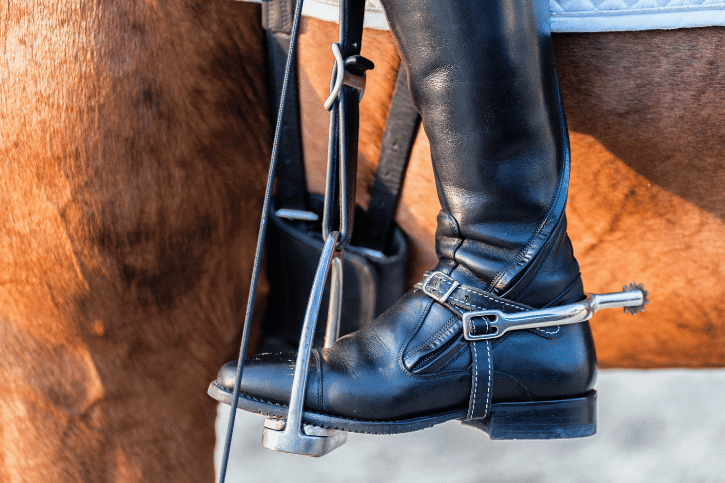Do Spurs Hurt Horses?
While watching an old western movie with my son the other day, he was asking about all the old kinds of equipment that they would use for horses.
He’s always been interested in cowboys and horses, as so many boys his age are.
But one thing he was quite concerned about was the use of spurs.
They looked like they would hurt the horse a lot, he said, and he was glad that no one used them anymore.
I told him I didn’t think they really hurt the horses if used right, but I decided to look into it anyway.
So, do spurs hurt horses?
If used correctly and properly made, a spur shouldn’t hurt a horse. The design of spurs has changed somewhat over the years, but the aim is never to cause pain to the horse to make it run. Experienced, knowledgeable riders who know how to use spurs can do so easily without hurting the horse.
So, we have many alternatives to spurs nowadays which more inexperienced riders can train with.
And, if used improperly, spurs certainly can very easily hurt horses.
But for the most part this doesn’t happen, and spurs are used correctly.
But let’s look at spurs as a whole and why they’re still favored in some places.
Are horse spurs cruel?
One way of it looking at this question is to say that spurs are only as cruel as the person using them.
Spurs are a very old method of controlling a horse, and our attitudes to animal care have come a long way since then.
In the past, using harsh spurs may have been an acceptable way of getting a horse to move, but things have changed now.
Spurs are designed to give a gentle nudge and jolt, a reinforcement of a command.
So, if the rider chooses to abuse their spurs, they may well end up being cruel and hurting the horse.
They could either do this wilfully, or simply because of a lack of training, but in the end, the spurs are not the problem.
The rider is.
Whether through lack of knowledge, impatience or frustration, new riders struggling to get control of their horse might abuse spurs.
The important thing to note, though, is the distance between spurs today and what spurs were like in the past.
Some spurs still are more jagged and star-shaped, but in general, modern spurs are just long, thin bits of metal on your boots.
You can give the horse’s side a little nudge to reinforce where you want it to go or what you want it to do.
So, all that said, are spurs really painful for horses?
Are spurs painful for horses?
In general, when used correctly and made correctly, spurs will not hurt your horse.
The advice is that beginners do not have the subtlety and control to effectively use spurs without running the risk of causing pain to the horse.
So, spurs are not essential to horse riding and you can ride without them.
So, this is the way to look at spurs: they’re an accessory for the advanced rider, who wants to gain an extra level of control over the horse.
Using the correct type of spurs is also essential, as it will depend on what kind of riding you are doing.
Dressage, for example, uses spurs that have short neck length, because the rider’s leg has close contact with the horse.
Western, rodeo-style riding uses a longer and wider style, typically the type you will see with rotating rowels.
So, once you’ve gotten to grips with how to use spurs, you’ve then got to get to grips with exactly which type fits your needs.
If you use the wrong type of spur in the wrong situation, you could cause your horse significant pain.
In general, however, if used properly by an experienced rider, spurs are not painful for the horse.
So, what do they actually do?
What do spurs do to a horse?
It’s difficult to imagine how responsive horses are to verbal commands.
They’re highly intelligent creatures, and, furthermore, their social disposition makes them very open to learning these commands.
Most of us might at one point have assumed that the whole point of spurs was to make the horse feel pain so that it would run faster.
This isn’t true at all.
Essentially, spurs act as a reinforcement of verbal and natural aids and commands.
Whether it’s a spoken command or the hands on the reins, giving a command and then backing it up with a jab of the saddles creates associations in the horse’s mind so that it knows what you want it to do.
It refines the commands and makes them more instinctive and reactive for your horse.
Their main function is to control direction, so the most basic way to think of it is that when a horse feels a jab in its left side, it should go one way and in its right side, the other way.
So, spurs as we might imagine them are harsh, jagged metal discs that hurt and dig into the horse in order to make it run.
But this isn’t really the case.
Spurs now are designed in an entirely different way and are not intended to cause the horse pain, but simply to issue a command.
The bottom line is that spurs should not be used by inexperienced riders as they are the ones who are most likely to hurt the horse this way.
